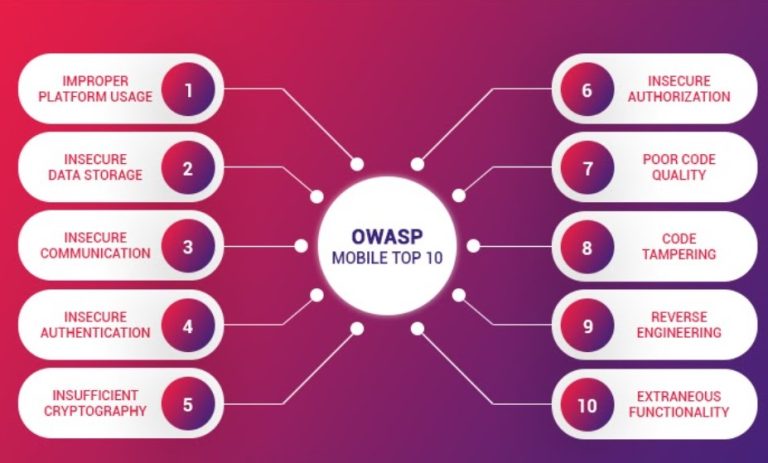Introduction:
More people use Android. Users want safe Android applications, thus we must be mindful of the dangers owasp has identified.

1.Improper Platform Usage:
This refers to the inappropriate use or abuse of platform-specific security features or safeguards, such as the storing of unencrypted data, insufficient encryption, or the use of unsecured communication channels.
Example: Storing private data or passwords in an unencrypted or unsafe manner on the device’s local storage.
Mitigation
- Establish user roles and permissions, and then restrict access to sensitive functionalities and data based on those roles to implement access controls.
- Update and patch the platform frequently: Update your security software and install patches to fix vulnerabilities and guard against future exploits.
- Implement logging and monitoring: Keep an eye on system activity, record events, and examine logs for questionable behaviour or platform abuse.
- Give user education and awareness: To avoid unintentional misuse, inform users about appropriate platform usage, security best practises, and potential risks.
2 Insecure Data Storage:
When sensitive data, including user credentials or private information, is kept insecurely on the device or in external storage, it becomes vulnerable to intrusion by unauthorised users.
Example scenarios include keeping user login information in plain text or using ineffective encryption that is simple for an attacker to get around.
Mitigations:
- Data at rest should be protected by strong encryption algorithms to ensure that even if the data is compromised, it remains unreadable.
- Put in place appropriate access controls: Only authorised users or roles should have access to sensitive data.
- Maintain current backups of important data to avoid loss or the need to pay ransoms in the event of a breach.
- Use secure coding techniques: Avoid common security flaws like SQL injection and other injection attacks that could result in data breaches.
-
Insecure Communication:
This risk is related to gaps in the mobile app’s communication with the backend server, where data may be intercepted, changed, or made accessible to unauthorised parties.
An illustration would be sending confidential information, like passwords or financial data, over an insecure HTTP connection as opposed to a secure HTTPS connection.
Mitigations:
- Utilise encrypted communication protocols: To secure data transmission over networks, use the Transport Layer Security (TLS) or Secure Sockets Layer (SSL) protocols.
- Validate and sanitise user input: Ensure that user input and data are protected against common vulnerabilities like injection attacks and cross-site scripting (XSS) by being sanitised, validated, and protected.
- Apply strict firewall guidelines: Configure firewalls to manage and keep an eye on network traffic while restricting access to approved communication channels.
4.Insecure Authentication
This refers to vulnerabilities related to authentication mechanisms, such as weak password policies, improper session management, or lack of multi-factor authentication, which can lead to unauthorized access to user accounts.
Example scenario: Allowing weak passwords with no complexity requirements or failing to implement proper session timeouts, allowing an attacker to hijack a user’s active session.
Mitigations:
- Implement multi-factor authentication (MFA): Require users to provide multiple forms of authentication (e.g., passwords and one-time codes) to verify their identity.
- Enforce password complexity: Set password policies that mandate strong passwords, including a minimum length, a mix of characters, and regular password expiration.
- Implement account lockouts and login throttling: Prevent brute-force attacks by locking out or delaying login attempts after a certain number of failed tries.
- Regularly review and disable unused accounts: Remove or disable accounts that are no longer needed to prevent unauthorized access.
5.Insufficient Cryptography
This risk involves weak or flawed cryptographic algorithms, improper key management, or inadequate implementation of encryption techniques, which can lead to data exposure or unauthorized decryption.
Example scenario: Using weak encryption algorithms or storing encryption keys in easily accessible locations, making it easier for an attacker to decrypt sensitive data.
Mitigations:
- Use strong cryptographic algorithms: Employ industry-standard encryption algorithms and hashing functions that are deemed secure.
- Keep software libraries and dependencies up to date: Ensure that the cryptographic libraries and components used in the application are updated with the latest security patches.
- Implement key management best practices: Safeguard cryptographic keys, manage their lifecycle, and ensure proper key rotation and revocation.
- Conduct regular security assessments: Perform penetration testing and code reviews to identify and address any weaknesses or vulnerabilities in the cryptography implementation.
6.Insecure Authorization
This vulnerability occurs when an app fails to properly enforce authorization controls, allowing an attacker to access restricted functionalities or perform unauthorized actions.
Example scenario: Failing to validate user permissions on server-side requests, allowing an attacker to access or manipulate data they should not have access to.
Mitigation:
- Apply strong authentication techniques like multi-factor authentication (MFA) and set up appropriate authorization checks to ensure that users can only access the resources that they are authorised to.
- Implement least privilege: Give users the minimal set of rights required for them to complete their tasks. To reduce the risk of unauthorised access, periodically review and update user roles and permissions.
- Audit and keep an eye on authorization activities on a regular basis: To track and identify any shady or unauthorised authorization attempts, put in place logging and monitoring mechanisms. Analyse logs frequently to look for possible security breaches.
7.Client Code Quality
This risk relates to security vulnerabilities in the mobile app’s client-side code, such as poor input validation, insecure storage of sensitive data, or lack of proper error handling.
Example scenario: Failing to validate user inputs, which could result in injection attacks or unintended data exposure.
Mitigations:
- Use secure coding practises: To create robust and secure client-side code, adhere to secure coding guidelines and best practises. This includes input validation, output encoding, and secure information handling.
- Perform code reviews and testing: Review client-side code for security vulnerabilities on a regular basis, and conduct comprehensive testing, including static analysis and dynamic testing, to identify and fix any flaws or weaknesses.
- Maintain client-side libraries and frameworks: Because outdated versions may contain exploitable vulnerabilities, ensure that the client-side libraries and frameworks used in the application are up to date.
-
Code Tampering
In order to create harmful behaviour or get beyond security measures, attackers may edit the app’s code, either by reverse engineering or fiddling with the binaries.
Example: Altering the app’s code to remove sensitive data, deactivate security measures, or carry out unauthorised operations.
Mitigations:
- Use techniques like code signing, checksums, or digital signatures to confirm that the code hasn’t been altered or tampered with. Implement code integrity checks.
- Use anti-tampering and obscuration techniques: Use techniques for code obfuscation to make it more difficult for attackers to decipher and manipulate the code. Use anti-tampering tools as well to spot any tampering efforts and react accordingly.
- Use secure update methods: To stop unauthorised changes, use secure update mechanisms for distributing updates to client-side code, including encrypted channels or digital signatures.
9. Reverse Engineering
This risk involves the unauthorized extraction of sensitive information or intellectual property from the mobile app’s binary, which can lead to data theft or the creation of malicious clones.
Example scenario: Extracting proprietary algorithms or sensitive data from the app’s code to gain a competitive advantage or launch an attack.
Mitigations:
- Use code obfuscation methods: To make it more difficult for attackers to decipher and comprehend the underlying logic.
- Use safeguards against reverse engineering: To prevent and obstruct reverse engineering attempts, use anti-reverse engineering strategies like code encryption, code obfuscation, or runtime protection measures.
- Employ legal safeguards: Speak with legal professionals to comprehend how to make use of nondisclosure agreements, intellectual property rights, and other legal safeguards to guard against unauthorised reverse engineering.
10.Extraneous Functionality
This refers to the presence of unnecessary or potentially insecure features or functionalities within the mobile app, which can introduce additional attack vectors or increase the app’s attack surface.
Example scenario: Including debug features or backdoor functionalities in the app’s code, which can be exploited by an attacker for malicious purposes.
Mitigations:
- Regularly review and remove unused or unnecessary features: Periodically evaluate the application and remove any functionalities or components that are not needed. Unnecessary functionalities can introduce additional attack vectors and increase the overall risk.
- Implement secure development practices: Apply secure coding guidelines and best practices to ensure that only essential and secure functionalities are included in the application.
- Conduct security testing and code reviews: Regularly assess the application’s code and functionalities through security testing, penetration testing, and code reviews to identify and eliminate any extraneous or vulnerable functionalities.
Conclusion;
With an understanding of mobile application risks, we can easily mitigate them and provide secure applications to users. Users must update their applications whenever a new version is released so that we can mitigate unknown threats as well.
For further clarifications or support, please write to contact@paradigmitcyber.com
